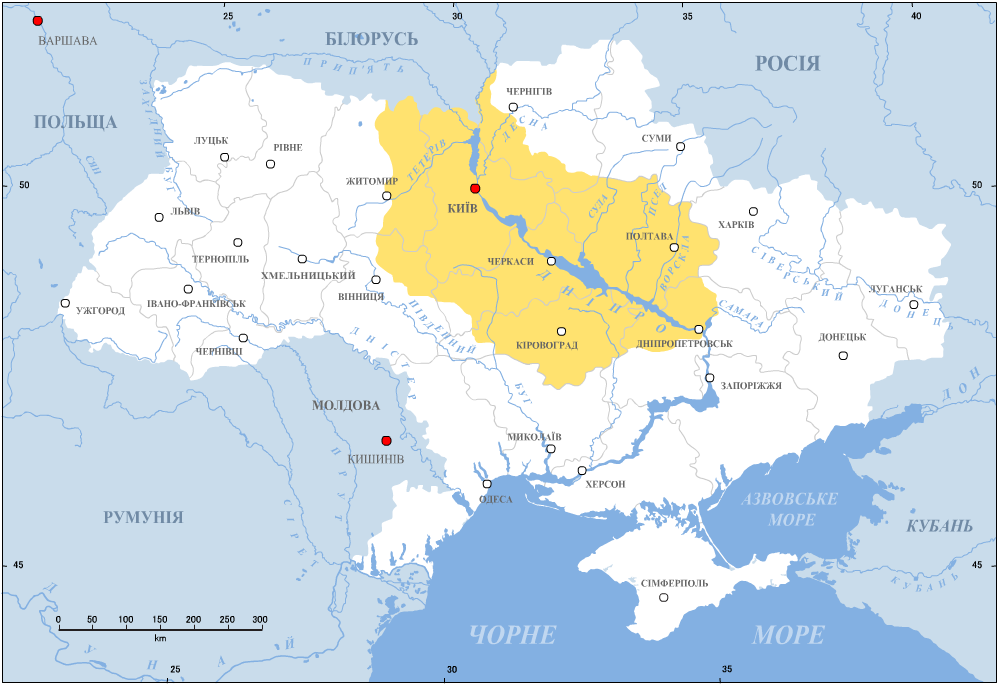Facts for Kids
The Dnieper River is a major Eastern European river, known for its length, historical significance, and ecological importance.
Overview
Hydrology
Cultural Impact
Environmental Issues
Geography And Course
Economy And Navigation
Tourism And Recreation
Historical Significance
Ecology And Biodiversity

Inside this Article
Taras Shevchenko
Biodiversity
Zaporizhzhia
Fresh Water
Ukrainian
Pollution
Hydrology
Mountains
Dnieper
Did you know?
🌍 The Dnieper River is one of the longest rivers in Europe, stretching over 2,200 kilometers.
🏞️ It flows through four countries: Russia, Belarus, Ukraine, and eventually drains into the Black Sea.
🏙️ The river is a significant waterway for trade and transportation in Eastern Europe.
🌿 The Dnieper is also known for its rich biodiversity, hosting many species of fish and birds.
🏔️ It originates from the Valdai Hills near Smolensk in Russia.
🚢 The Dnieper features several hydroelectric power stations, contributing to the energy supply in the region.
💧 The river's basin is home to nearly 30 million people, making it one of the most populous river basins in Europe.
🌉 The city of Kyiv, the capital of Ukraine, is situated on the banks of the Dnieper.
🚣♂️ The river has been a vital cultural and historical route for centuries, with numerous ancient cities along its banks.
🦢 The Dnieper is often noted for its picturesque landscapes and serene beauty.
Introduction
️ It flows through four countries: Russia, Belarus, Ukraine, and it empties into the Black Sea. 🌊
The river is famous for its beautiful landscapes, rich history, and recreational opportunities. The Dnieper has important cities along its banks, such as Kyiv, the capital of Ukraine. It's not just a river; it’s a lifeline for the people living along its shores! With fresh water and fish, the Dnieper River plays a big role in the daily lives of many families. 🐟
Hydrology
This means that its water level can change with the seasons. In spring, melting snow and rain can cause the river to swell, while in summer and fall, the levels might go down. Dams and reservoirs, like the Dnieper Hydro Power Plant, help control these changes and provide electricity to many people! The river’s flow supports a variety of wildlife and keeps the ecosystems along its banks thriving. Understanding its hydrology helps us appreciate how rivers work! 🌞
Cultural Impact
It has inspired artists and writers throughout history, showcasing its beauty and importance. In Ukraine, the river is often seen as a symbol of national pride. It’s mentioned in famous works, such as the poetry of Taras Shevchenko. 🎨
The Dnieper is also important for traditional festivals that celebrate nature and heritage. Local communities often come together for riverbanks events, where stories are told, dances are performed, and delicious food is shared! 🍲
Environmental Issues
Pollution from factories and sewage can harm the water quality, affecting fish and plants. Additionally, deforestation along the riverbanks leads to erosion and habitat loss for wildlife. Some scientists and activists work hard to protect the Dnieper and educate people on keeping it clean. 🌱
By raising awareness, communities can join forces to help restore and care for this incredible river and ensure it remains a beautiful place for communities and wildlife alike! 🐢
Geography And Course
️ The river’s path winds through forests, mountains, and plains, creating stunning views. The Dnieper has many tributaries, like the Pripyat River, which help it carry water and nutrients. In Ukraine, the river creates a natural border between east and west. The riverbanks are also home to many towns and villages, making it an essential part of people's lives. 🌳
It’s a great place for boating, fishing, and exploring nature! 🚣
Economy And Navigation
Boats and barges travel its waters, carrying goods between cities and towns. Major cities like Kyiv and Zaporizhzhia depend on the river for shipping. Docks and ports help businesses to transport food, raw materials, and other products. The river also provides fresh water for irrigation, helping farmers grow food. It’s essential for the economy of the region that the Dnieper remains healthy and navigable for everyone! 🌾
Tourism And Recreation
️ Tourists love visiting for boating, fishing, and picnicking along its shores. In Kyiv, you can take scenic boat tours to see historic buildings from the water! 🌅
Families often enjoy cycling along river paths or relaxing in parks. The river also hosts fun festivals with food, music, and games. Tourists can explore stunning natural areas, wildlife, and rich cultures by visiting the Dnieper. The beautiful scenery attracts visitors from all over Europe! 🌍
Historical Significance
️ Ancient cultures like the Vikings and the Slavs used it for trade and travel. Some legends say that it helped people connect from one side of Europe to the other! The river also played a significant role in World War II, as it was a strategic point for battles. Today, the Dnieper is celebrated in songs, art, and stories in Ukrainian culture. 📜
The famous Dnieper rapids represented a challenge for sailors, making them a legendary part of the river’s history.
Ecology And Biodiversity
In its waters, you can find fish like carp and catfish, while the banks are filled with trees and flowers. This river creates habitats for birds, frogs, and turtles. Some parts of the river even have wetlands, which are homes for lots of creatures! 🌿
The river ecosystem is essential for maintaining biodiversity, as different species rely on each other to survive. Protecting the Dnieper’s environment helps ensure that animals and plants can thrive for years to come! 🌺

